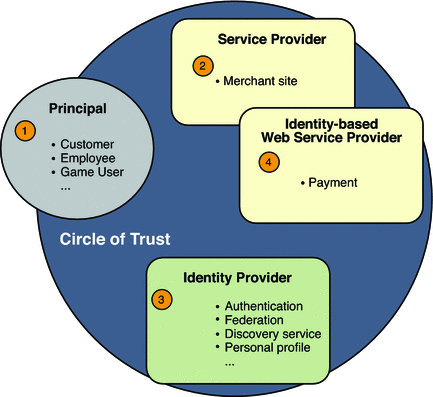Understanding Typical Business Use Cases
The adoption of identity web services is widespread especially in mobile communications-based businesses. Many of the telecommunication industries in Europe have invested heavily in ID-WSF based architectures, although the adoption in US is relatively smaller.
The following figure illustrates a simple E-commerce deployment using OpenSSO Enterprise.
Figure 10–7 Identity Web Services Business Use Case

-
The customer is browsing the merchant site and initiates a purchase of some item.
-
The merchant who needs to authenticate the customer can request authentication through one of the trusted Identity Providers. The authentication happens here through ID-FF or SAMLv2, masking the real identity of the customer. This helps preserve the customer's privacy.
-
The merchant requests the payment service to guarantee the transaction. First the merchant site discovers the customer payment service through the Discovery Service. Then the merchant site requests the payment services on behalf of the principal. This step leverages the fact that the Liberty discovery mechanism is per principal-oriented, allowing merchants to request payments without having to know the real customer identity.
-
The payment service validates the transaction. Before charging the customer, the payment service may take a user consent. The payment service uses the Liberty Interaction Service for doing this. With successful purchase, the merchant returns the confirmation of purchase and delivers the service.
- © 2010, Oracle Corporation and/or its affiliates
